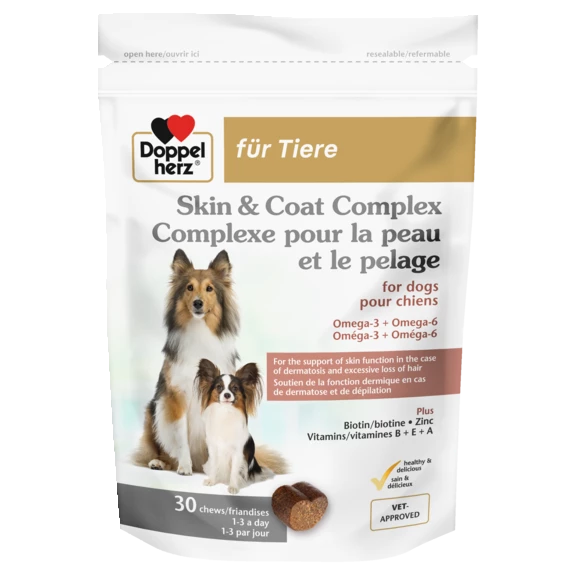If you notice that your dog scrubs, scratches or gnaws its skin unusually often, this can have various causes. Allergies are often responsible, which can also manifest themselves in so-called "hotspots". But hormonal disorders can also trigger skin changes. For example, an underactive thyroid gland can lead to dry, cracked, scaly skin and a thinning coat. Other typical causes of skin diseases in dogs are bacterial infections and fungal infections. Fungal infections often cause bald patches and itching. Infestation by parasites such as fleas, mites or lice can also cause skin diseases in dogs and often leads to severe itching.
Depending on the cause and severity, skin diseases can cause very different symptoms. The appearance ranges from inconspicuous redness to dry, scaly skin to bloody, oozing wounds. Typical signs of skin diseases in dogs are frequent rubbing, licking or rolling, as skin irritations are usually accompanied by severe itching. Attempts by the dog to relieve the itching by rubbing can sometimes make the problems much worse: Due to the mechanical stress on the skin, even an irritation that initially seems relatively harmless can become a bleeding, oozing wound. This is often accompanied by a complete loss of fur on the corresponding parts of the body. It also increases the risk of infection, as open wounds immediately become entry points for bacteria and other microorganisms. In order to treat skin diseases quickly and at the earliest possible stage, dog owners should consult a veterinarian if they notice changes in the coat or skin or if the animal shows conspicuous behaviour such as scratching, licking or rolling. The veterinarian has various methods at his disposal to make a diagnosis:
Skin swabs, tissue and hair samples as well as blood tests can be used to identify pathogens or a systemic disease as possible causes. A clarification of allergies is usually more complex and can be carried out, for example, by means of an exclusion diet.
The treatment of skin diseases in dogs depends on the respective cause. In the case of a parasite infestation, for example, special products for parasite treatment such as sprays, spot-ons or powders are available. Fungal infections, on the other hand, are treated with an antimycotic, while an antibiotic helps with bacterial infections.
Hair changes due to disease or nutritional factors
Coat problems can be recognised relatively clearly in all dogs. There are changes in the coat, which can manifest themselves as follows:
- slight brittleness
- Dull, lusterless hair
- greasy, oily hair
- Increased hair loss outside the shedding period
- Thinned out areas of hair or completely hairless areas
- No firm hold of hair or whole tufts of hair
These symptoms can also be accompanied by altered skin (dandruff, redness) as well as other symptoms such as bad body odour, itching and/or frequent licking of certain areas of the skin. However, it is rarely possible to draw definitive conclusions about a specific disease based on these numerous non-specific factors. If your dog suffers from skin or coat problems, it is therefore always advisable to consult a veterinarian for a precise diagnosis.
